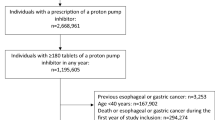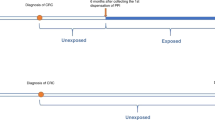Abstract
Background
Acid-suppressant medications, including proton pump inhibitors (PPIs) and H2 receptor antagonists (H2RAs), are frequently prescribed and have been linked to increased risk of some gastrointestinal cancers.
Aims
We examined whether post-diagnosis use of PPIs/H2RAs is associated with the risk of mortality in gastrointestinal cancer patients.
Methods
We used data from patients with esophageal cancer, gastric cancer, or hepatocellular carcinomas (HCCs) in the national VA Central Cancer Registry diagnosed between 2002 and 2016. We identified PPI/H2RA prescriptions that were filled before and after cancer diagnosis and used time-dependent Cox regression models to calculate adjusted hazard ratios (HRs) and 95% CIs for mortality risk. We used a time-varying exposure to avoid immortal-time bias and a 3-month lag to reduce reverse causation. A sensitivity analysis was conducted varying the lag duration between the date of cancer diagnosis and the start of follow-up.
Results
PPIs were used by the majority (54% post-diagnosis use) of patients. We found no association between post-diagnosis PPI use and cancer-specific mortality in esophageal adenocarcinoma (HR 0.93; 95% CI 0.84–1.02), esophageal squamous cell carcinoma (HR 0.99; 95% CI 0.87–1.12), or gastric cardia cancer (HR 1.04; 95% CI 0.89–1.22) patients. Post-diagnosis PPI use was, however, associated with the increased risk of cancer-specific mortality for patients with gastric non-cardia cancer (HR 1.50; 95% CI 1.29–1.74) and HCC (HR 1.31; 95% CI 1.23–1.40). The results were similar for associations with post-diagnosis use of H2RAs. There was no association with pre-diagnosis PPI/H2RA use.
Conclusion
Post-diagnosis PPI/H2RA use was associated with the increased mortality in gastric non-cardia cancer and HCC patients.
Similar content being viewed by others
References
Thrift AP, Whiteman DC. The incidence of esophageal adenocarcinoma continues to rise: analysis of period and birth cohort effects on recent trends. Ann Oncol. 2012;23:3155–3162.
Wang Z, Graham DY, Khan A, et al. Incidence of gastric cancer in the USA during 1999 to 2013: a 50-state analysis. Int J Epidemiol. 2018;47:966–975.
Anderson WF, Rabkin CS, Turner N, et al. The changing face of noncardia gastric cancer incidence among US non-Hispanic Whites. J Natl Cancer Inst. 2018;110:608–615.
White DL, Thrift AP, Kanwal F, et al. Incidence of Hepatocellular Carcinoma in All 50 United States, from 2000 through 2012. Gastroenterology. 2017;152:812–820.e5.
Surveillance E, and End Results (SEER) Program (www.seer.cancer.gov) SEER*Stat Database: Incidence—SEER 9 Regs Research Data, Nov 2014 Sub (1973-2012) <Katrina/Rita Population Adjustment>—Linked To County Attributes—Total U.S., 1969–2013 Counties, National Cancer Institute, DCCPS, Surveillance Research Program, Surveillance Systems Branch, released April 2015, based on the November 2014 submission.
Savarino V, Di Mario F, Scarpignato C. Proton pump inhibitors in GORD an overview of their pharmacology, efficacy and safety. Pharmacol Res. 2009;59:135–153.
Brusselaers N, Engstrand L, Lagergren J. Maintenance proton pump inhibition therapy and risk of oesophageal cancer. Cancer Epidemiol. 2018;53:172–177.
Brusselaers N, Wahlin K, Engstrand L, et al. Maintenance therapy with proton pump inhibitors and risk of gastric cancer: a nationwide population-based cohort study in Sweden. BMJ Open. 2017;7:e017739.
Cheung KS, Chan EW, Wong AYS, et al. Long-term proton pump inhibitors and risk of gastric cancer development after treatment for Helicobacter pylori: a population-based study. Gut. 2018;67:28–35.
Tran KT, McMenamin UC, Hicks B, et al. Proton pump inhibitor and histamine-2 receptor antagonist use and risk of liver cancer in two population-based studies. Aliment Pharmacol Ther. 2018;48:55–64.
Shao YJ, Chan TS, Tsai K, et al. Association between proton pump inhibitors and the risk of hepatocellular carcinoma. Aliment Pharmacol Ther. 2018;48:460–468.
Kao WY, Su CW, Chia-Hui Tan E, et al. Proton pump inhibitors and risk of hepatocellular carcinoma in patients with chronic hepatitis B or C. Hepatology. 2019;69:1151–1164.
Jackson GL, Melton LD, Abbott DH, et al. Quality of nonmetastatic colorectal cancer care in the Department of Veterans Affairs. J Clin Oncol. 2010;28:3176–3181.
Zullig LL, Jackson GL, Dorn RA, et al. Cancer incidence among patients of the U.S. Veterans Affairs Health Care System. Mil Med. 2012;177:693–701.
Sohn MW, Arnold N, Maynard C, et al. Accuracy and completeness of mortality data in the Department of Veterans Affairs. Popul Health Metr. 2006;4:2.
Davila JA, Duan Z, McGlynn KA, et al. Utilization and outcomes of palliative therapy for hepatocellular carcinoma: a population-based study in the United States. J Clin Gastroenterol. 2012;46:71–77.
Kamath PS, Wiesner RH, Malinchoc M, et al. A model to predict survival in patients with end-stage liver disease. Hepatology. 2001;33:464–470.
Levesque LE, Hanley JA, Kezouh A, et al. Problem of immortal time bias in cohort studies: example using statins for preventing progression of diabetes. BMJ. 2010;340:b5087.
Targownik LE, Suissa S. Understanding and avoiding immortal-time bias in gastrointestinal observational research. Am J Gastroenterol. 2015;110:1647–1650.
Zhou Z, Rahme E, Abrahamowicz M, et al. Survival bias associated with time-to-treatment initiation in drug effectiveness evaluation: a comparison of methods. Am J Epidemiol. 2005;162:1016–1023.
Fisher LD, Lin DY. Time-dependent covariates in the Cox proportional-hazards regression model. Annu Rev Public Health. 1999;20:145–157.
Xie Y, Bowe B, Li T, et al. Risk of death among users of proton pump inhibitors: a longitudinal observational cohort study of United States veterans. BMJ Open. 2017;7:e015735.
Xie Y, Bowe B, Yan Y, et al. Estimates of all cause mortality and cause specific mortality associated with proton pump inhibitors among US veterans: cohort study. BMJ. 2019;365:l1580.
Tvingsholm SA, Dehlendorff C, Osterlind K, et al. Proton pump inhibitor use and cancer mortality. Int J Cancer. 2018;143:1315–1326.
Papagerakis S, Bellile E, Peterson LA, et al. Proton pump inhibitors and histamine 2 blockers are associated with improved overall survival in patients with head and neck squamous carcinoma. Cancer Prev Res (Phila). 2014;7:1258–1269.
Miftahussurur M, Yamaoka Y, Graham DY. Helicobacter pylori as an oncogenic pathogen, revisited. Expert Rev Mol Med. 2017;19:e4.
Tan MC, Graham DY. Proton pump inhibitor therapy after Helicobacter pylori eradication may increase the risk of gastric cancer. BMJ Evid Based Med. 2018;23:111–112.
Lagergren J, Bergstrom R, Lindgren A, et al. Symptomatic gastroesophageal reflux as a risk factor for esophageal adenocarcinoma. N Engl J Med. 1999;340:825–831.
Fais S, Venturi G, Gatenby B. Microenvironmental acidosis in carcinogenesis and metastases: new strategies in prevention and therapy. Cancer Metastasis Rev. 2014;33:1095–1108.
Caplin M, Khan K, Savage K, et al. Expression and processing of gastrin in hepatocellular carcinoma, fibrolamellar carcinoma and cholangiocarcinoma. J Hepatol. 1999;30:519–526.
Kucuk HF, Akyol H, Kaptanoglu L, et al. Effect of proton pump inhibitors on hepatic regeneration. Eur Surg Res. 2006;38:322–328.
Shi JH, Line PD. Effect of liver regeneration on malignant hepatic tumors. World J Gastroenterol. 2014;20:16167–16177.
Morgan RO, Petersen LA, Hasche JC, et al. VHA pharmacy use in veterans with Medicare drug coverage. Am J Manag Care. 2009;15:e1–e8.
Mittal S, Sada YH, El-Serag HB, et al. Temporal trends of nonalcoholic fatty liver disease-related hepatocellular carcinoma in the veteran affairs population. Clin Gastroenterol Hepatol. 2015;13:594–601.
Funding
This work was supported in part by National Institutes of Health grant P30 DK056338 (Study Design and Clinical Research Core), which supports the Texas Medical Center Digestive Diseases Center. This research was supported in part with resources at the VA HSR&D Center for Innovations in Quality, Effectiveness and Safety (#CIN 13-413), at the Michael E. DeBakey VA Medical Center, Houston, TX. The opinions expressed reflect those of the authors and not necessarily those of the Department of Veterans Affairs, the United States government or Baylor College of Medicine.
Author information
Authors and Affiliations
Contributions
APT was involved in study concept and design. APT and YL performed statistical analysis and interpretation of data. HES and APT were involved in acquisition of data and obtained funding. YL prepared the data. SA, MCT, HES, and APT drafted the manuscript. SA, MCT, YL, HES, and APT were involved in critical review of the manuscript for important intellectual content. All authors read and approved the final version for submission.
Corresponding author
Ethics declarations
Conflict of interests
None.
Additional information
Publisher's Note
Springer Nature remains neutral with regard to jurisdictional claims in published maps and institutional affiliations.
Electronic supplementary material
Below is the link to the electronic supplementary material.
Rights and permissions
About this article
Cite this article
Ayyagari, S., Tan, M.C., Liu, Y. et al. Use of Acid-Suppressant Medications After Diagnosis Increases Mortality in a Subset of Gastrointestinal Cancer Patients. Dig Dis Sci 65, 2691–2699 (2020). https://doi.org/10.1007/s10620-019-05984-x
Received:
Accepted:
Published:
Issue Date:
DOI: https://doi.org/10.1007/s10620-019-05984-x




